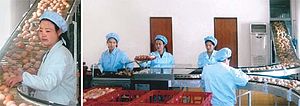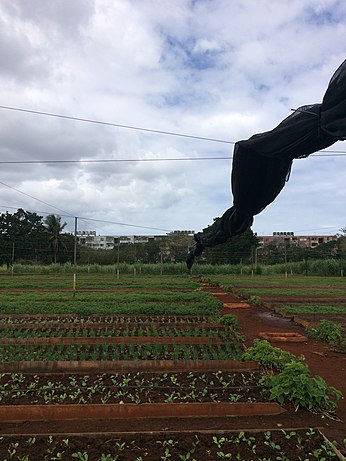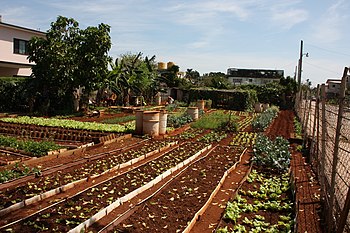The good life in Havana: Cuba's green revolution - Independent Online Edition > Americas
The good life in Havana: Cuba's green revolution
Twenty years ago, following the collapse of the Soviet empire, Fidel Castro's small island faced a food crisis. Today, its network of small urban farmers is thriving, an organic success story that is feeding the nation. Andrew Buncombe reports
Published: 08 August 2006
To the right lay revolutionary tomatoes and to the left lay revolutionary lettuces, while in the glass in my hand - filled to the brim and frothing with vitality - was the juice from revolutionary mangoes. It was thick, unfiltered and fabulously sweet. It was also organic.
"Yes, it is very good. It's all natural," said Miguel Salcines Lopez, his brow dotted with sweat from the midday sun, as he raised a glassful to his lips. "Growing food in this way is much more interesting. It is much more intelligent," he adds.
Almost five decades after the now ailing Fidel Castro and his comrades overthrew the dictator Fulgencio Batista and seized power in Cuba, another revolution, largely unnoticed by most visitors and tourists, is well underway on this Caribbean island. And Mr Salcines and his small urban farm at Alamar, an eastern suburb of the capital, Havana, are at the centre of a social transformation that may turn out to be as important as anything else that has been achieved during Castro's 47 years in power.
Spurred into action by the collapse of the Soviet Union and the disastrous impact this had on its subsidised economy, the government of Cuba was forced to take radical steps to feed its people. The solution it chose - essentially unprecedented both within the developed and undeveloped world - was to establish a self-sustaining system of agriculture that by necessity was essentially organic.
Laura Enriquez, a sociologist at the University of California Berkeley, who has written extensively on the subject of Latin American agriculture, said: "What happened in Cuba was remarkable. It was remarkable that they decided to prioritise food production. Other countries in the region took the neo-liberal option and exported 'what they were good at' and imported food. The Cubans went for food security and part of that was prioritising small farmers."
Cuba is filled with more than 7,000 urban allotments or "organoponicos", which fill perhaps as many as 81,000 acres. They have been established on tiny plots of land in the centre of tower-block estates or between the crumbling colonial homes that fill Havana. One afternoon I visited a small garden of tomatoes and spinach that had been dug just a few hundred yards from the Plaza de la Revolution, a vast concrete square where Castro and his senior regime members annually oversee Cuba's May Day parade. More than 200 gardens in Havana supply its citizens with more than 90 per cent of their fruit and vegetables.
Of all these gardens, the Vivero Organoponico Alamar is considered one of the most successful. Established less than 10 years ago, the 0.7 hectare plot employs about 25 people and provides a range of healthy, low-cost food to the local community. The hand-written blackboard at the shop attached to the garden listed mangoes at the equivalent of 2p a pound, black beans at about 15 pence and plantains for 12p. Everything looked as if it had been picked just that morning, which it probably had.
Mr Salcines led a brief tour of his garden, stopping off to point out things of which he was particularly proud. There was the shed of tomatoes that had produced five tons of fruit in six months, a self-designed metal pyramid structure which he claimed focused natural energy and benefited not just the plants but the gardeners as well; a worm farm wriggling with California Red worms and the bright marigolds planted at the end of each row of vegetables to attract bees and butterflies. He was also very proud of his crop of splendid, shiny mint. "The Hotel Nacional [Havana's state-run landmark hotel once frequented by the likes of Al Capone] uses our mint for its mojitos [a mint-based cocktail]," he said. "It's because it's organic."
The economics of various organoponicos differ. At the Metropolitana Organoponico in the city centre, two of the four workers who tend the plot said that the land was owned by the government and that everything grown there was split 50-50. "It's very good. It means that food does not have to be brought into the city," said one of the men.
At Alamar, Mr Salcines said that once the workers had grown their set quota of food and given that to the government, the surplus was theirs to sell with the profits then divided among them. Such a sense of co-operation - along with the free meals for the workers - added to the heady sense of idealism at Alamar, the sort of socialist idealism that has earned Cuba many international supporters over the years, despite Castro's dictatorial rule and his repression of political dissent.
Such farms barely existed in the late 1980s. Back then, Cuba's economy was extraordinarily reliant on subsidies from its political older brother, the Soviet Union. It's agriculture was designed with one aim in mind - namely to produce as much sugar cane as possible, which the Soviets bought at more than five times the market price, in addition to purchasing 95 per cent of its citrus crop and 73 per cent of its nickel. In exchange, the Soviets provided Cuba with 63 per cent of its food imports and 90 per cent of its petrol. Such a relationship made Cuba extraordinarily vulnerable. With the collapse of the Soviet Union, such subsidies halted almost overnight. Suddenly, the future looked bleak.
Nowhere was the impact felt more strongly than in the stomachs of the ordinary people. Figures produced by the UN Food and Agriculture Organisation (UNFAO) suggest that the daily calorie intake of the average Cuban fell from about 2,600 calories a day in the late 1980s to between 1,000 and 1,500 by 1993. Essentially, people were having to get by on about half the food they had been eating.
With no subsidies and limited resources, the Cuban regime took the decision to look inwards. Ceasing to organise its economy around the export of "tropical products" and the import of food, it decided to maximise food production. By necessity, this meant a back-to-basics approach; with no Soviet oil for tractors or fertiliser it turned to oxen, with no Soviet oil for its fertiliser and pesticide it turned to natural compost and the production of natural pesticides and beneficial insects. It is estimated that more than 200 locally based centres specialising in biopesticides annually produce 200 tons of verticillium to control whitefly, and 800 tons of beaveria sprays to control beetles.
Professor Jules Pretty, of the University of Essex's department of biological sciences, recently wrote: "Cut banana stems baited with honey to attract ants are placed in sweet potato fields and have led to control of sweet potato weevil. There are 170 vermicompost centres, the annual production of which has grown from 3 to 9,300 tons. Crop rotations, green maturing, intercropping and soil conservation have all been incorporated into polyculture farming."
Remarkably, this organic revolution has worked. Annual calorie intake now stands at about 2,600 a day, while UNFAO estimates that the percentage of the population considered undernourished fell from 8 per cent in 1990-2 to about 3 per cent in 2000-2. Cuba's infant mortality rate is lower than that of the US, while at 77 years life expectancy is the same.
Everyone appears to agree that this new, organic approach is far more efficient than the previous Soviet model that stressed production at all costs. Fernando Funes, head of the national Pasture and Forage Research Unit, told Harper's magazine: "In that old system it took 10 or 15 units of energy to produce one unit of food energy. At first we did not care about economics, [but] we were realising just how inefficient it was."
A second step Cuba took in the mid-1990s to try to save its economy was the establishment of mass tourism. Yet while this has provided the government with a ready source of millions of dollars in hard currency, it has also helped produce a dual-track society with its own tensions and clear divide between those who have access to foreign currency - or the Cuban Convertible Peso - and those who make do with the lowly Cuban peso, which cannot be used to buy many goods.
By contrast, Mr Salcines believes the introduction of organoponicos - a loosening of government control that also saw small restaurants and some private businsesses established - has been a success. He also believes these allotments have stayed true to Cuba's revolutionary ideas.
"Not everything is perfect," said Mr Salcines. "But if you look what capitalism has done for other countries in the region, I believe that the situation for poor people is better in Cuba. Our society is more equal. "
Experts, such as Professor Pretty, believe Cuba may be one of the only countries in the world to have adopted wholesale a self-sustaining system of agriculture. "They had no choice," he said. "Their only choice was to look inwards, to the resources they had and say: 'Can we make more of these resources?'"
Champions of organic, non-intensive agriculture might cite Cuba as an example that other countries could adopt rather than following the large-scale, industrial agriculture system. But could Cuba's labour-intensive example be repeated without the availability of large numbers of enforced workers? "I don't know. I think it is true that it has required much labour," said Professor Pretty. "The thing is that it has also produced a lot of food ... People are also closer to their food production. [In the west] we are worried that we don't know about where our food comes from. In Havana, people are closer to their food production and that may also have psychological benefits."
The same day as visiting the allotment at Alamar, I took a visit to the other side of Cuba's dual-track economy. The Hotel Nacional has hosted the likes of Winston Churchill and Fred Astaire, and more recently Naomi Campbell and Leonardo DiCaprio. On a lawn overlooking the ocean, I paid the equivalent of an ordinary Cuban's weekly wage paid for a mojito. It tasted great, but it didn't taste of the revolution.
Interesting? Click here to explore further















